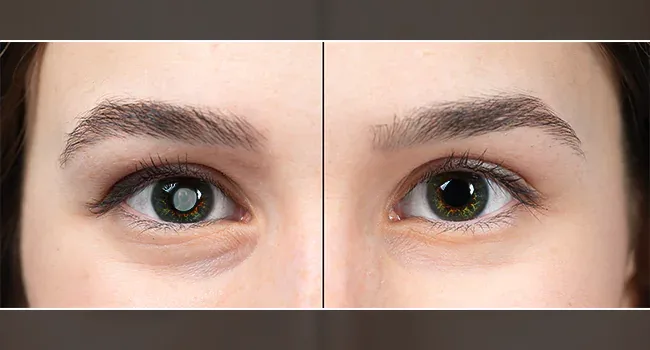What Is Phacoemulsification Surgery?
Phacoemulsification cataract surgery is a modern technique for removing cataracts, clouded areas in the eye’s natural lens that cause vision impairment. The procedure involves using ultrasonic vibrations to break up the cloudy lens, allowing it to be removed through a small incision. An intraocular lens (IOL) is then implanted to restore clear vision.
Phacoemulsification surgery is a minimally invasive cataract removal procedure that has become the standard due to its safety, precision, and quicker recovery time. It requires only a tiny corneal incision, reducing the risk of complications and enhancing post-operative healing.
Who Is Eligible for Phacoemulsification Cataract Surgery?
Phacoemulsification cataract surgery is suitable for most individuals diagnosed with cataracts that affect daily activities. However, eligibility depends on:
- The severity of cataracts and their impact on vision
- Overall eye health, including corneal integrity
- Absence of severe ocular conditions such as advanced glaucoma or retinal diseases
- General health factors, such as controlled diabetes or hypertension
Phacoemulsification Procedure: Step-by-Step
Phacoemulsification Steps
- Preoperative Preparation – The patient undergoes a comprehensive eye examination, and eye drops are used to dilate the pupil.
- Anesthesia – Local or topical anesthesia is administered to numb the eye.
- Corneal Incision – A small incision, typically 2-3 mm, is made in the cornea.
- Capsulorhexis – A circular opening is created in the lens capsule to access the cataract.
- Phacoemulsification – Ultrasonic energy is used to break the cataract into tiny fragments, which are then suctioned out.
- Lens Implantation – An artificial intraocular lens (IOL) is inserted in place of the removed cataract.
- Incision Closure – The small incision is self-sealing and usually does not require stitches.
Types of Phacoemulsification
There are different types of phacoemulsification, including:
- Conventional Phacoemulsification – Uses ultrasound energy to break the cataract.
- Femtosecond Laser-Assisted Phacoemulsification – Utilizes laser technology for enhanced precision in lens fragmentation.
Phacoemulsification Surgery Cost
The phacoemulsification surgery cost varies based on factors such as:
- The type of intraocular lens selected
- The healthcare facility and its location
- The surgeon’s experience and expertise
- Whether additional tests or treatments are required
Advantages of Phacoemulsification
There are several advantages of Phacoemulsification over traditional cataract surgery:
- Minimally Invasive: The procedure involves a small incision, reducing the risk of infection and promoting faster healing.
- Quick Recovery: Most patients experience significant vision improvement within a few days, allowing them to return to normal activities sooner.
- Improved Vision Quality: Modern intraocular lenses allow many patients to achieve better visual outcomes and reduce their dependence on glasses.
- Lower Risk of Complications: Compared to older techniques, phacoemulsification has a lower risk of corneal swelling and inflammation.
- No Need for Stitches: The self-sealing incision eliminates the need for sutures, making the healing process smoother and more comfortable.
Disadvantages of Phacoemulsification
While phacoemulsification is a highly effective surgery, there are some potential drawbacks. The following are some disadvantages of phacoemulsification:
- Risk of Posterior Capsule Opacification (PCO): Some patients may develop clouding of the lens capsule, which may require a laser procedure to correct.
- Intraocular Pressure Fluctuations: Some patients may experience temporary changes in eye pressure following surgery.
- Corneal Swelling: Although rare, some individuals may experience temporary corneal swelling, leading to mild discomfort.
- Possibility of Infection: As with any surgical procedure, there is a small risk of post-operative infection, which can be mitigated with proper aftercare.
- Adjustment Period for IOLs: Some patients take time to adapt to their intraocular lenses, especially if multifocal or toric lenses are used.
Here is a detailed guide on the risks of phacoemulsification.
Advantages vs Disadvantages of Phacoemulsification
| Aspect | Advantages | Disadvantages |
| Surgical Incision | Small, self-sealing | Minimal risk of infection |
| Recovery Time | Quick, within days | Some patients may take longer |
| Vision Outcome | Improved clarity | Possible PCO development in a few months to years |
| Need for Glasses | Reduced dependence | Some may still need glasses |
| Complications | Lower risk overall | Rare but possible infection risk |
Is Phacoemulsification Safe?
Phacoemulsification is considered a safe and effective surgical method for cataract removal. However, as with any surgical procedure, risks exist, including:
- Mild discomfort or dryness post-surgery
- Temporary vision fluctuations during the healing process
- Rare cases of retinal detachment or intraocular pressure fluctuations
Precautions to Take After Phacoemulsification Surgery
To ensure a smooth recovery, patients should follow these precautions:
- Use prescribed eye drops as directed
- Avoid rubbing or pressing on the operated eye
- Refrain from heavy lifting and strenuous activities for a few weeks
- Wear protective eyewear when outdoors
- Attend all follow-up visits to monitor healing
Don’t let cataracts affect your daily activities. Learn More About Your Treatment Options!
FAQs
Which is better, phaco eye surgery or laser eye surgery for cataracts?
Phacoemulsification is the preferred surgical method for cataracts, while femto surgery is often used to further enhance accuracy and hasten recovery.
What is the difference between phacoemulsification and cataract surgery?
Phacoemulsion surgery is a modern cataract surgery technique that uses ultrasound to break up the lens, while “cataract surgery” is a broad term encompassing various methods, with phaco surgery being the most common.
What is the difference between phaco and mics cataract surgery?
Phacoemulsification (phaco) and microincisional cataract surgery (MICS) is the advanced version of phaco that involves smaller incisions (<2mm), potentially leading to quicker recovery.
Is Phaco surgery painful?
No, phacoemulsification surgery is typically not painful. Local anesthesia is used to numb the eye, and patients may feel pressure but not pain during the procedure.
What is the disadvantage of phaco?
Potential disadvantages may include rare complications like infection or inflammation.
Who is a good candidate for Phacoemulsification?
Most individuals with cataracts are suitable candidates for phacoemulsion surgery, but a thorough eye examination is needed to determine eligibility.
How long does a Phacoemulsification procedure typically take?
The surgery itself usually takes around 15 to 30 minutes, but overall time at the surgical center may be longer due to pre and postoperative processes.
How soon can I expect to see improvements in my vision after Phacoemulsification?
Vision improvement is often noticeable within a few hours after surgery, with optimal results achieved over several weeks.
Are there any restrictions on activities following Phacoemulsification?
Strenuous activities should be avoided initially, but most patients can resume normal daily activities within a day or two.
How long does it take to fully recover from Phacoemulsification?
Full recovery varies, but patients can generally expect a few weeks for complete healing and optimal visual results.
Can Phacoemulsification correct other vision problems besides cataracts?
Phacoemulsification primarily addresses cataracts; other vision issues may require additional interventions or procedures.
How long does it take to recover from phacoemulsification cataract surgery?
Most patients experience noticeable vision improvement within a few days. Full recovery may take a few weeks, depending on individual healing. Regular follow-ups help monitor progress and address any concerns.
Can both eyes undergo phacoemulsification at the same time?
Typically, phacoemulsification is performed on one eye at a time, with a gap of a few days to weeks between procedures for the second eye. This approach minimizes risks and ensures better healing. In select cases, with specific indications, phacoemulsification of both eyes may be done on the same day.
Will I need glasses after phacoemulsification cataract surgery?
This depends on the type of intraocular lens used. Some premium IOLs reduce dependency on glasses for both near and distant vision, while standard lenses may still require corrective eyewear.
What are the possible side effects of phacoemulsification?
Common side effects include temporary blurred vision, mild irritation, and light sensitivity. These symptoms usually resolve within a few days with proper post-operative care.
How do I know if I need phacoemulsification cataract surgery?
If cataracts are affecting your daily activities, such as reading or driving, an eye specialist may recommend the procedure. A comprehensive eye exam will determine the severity and best treatment plan.





